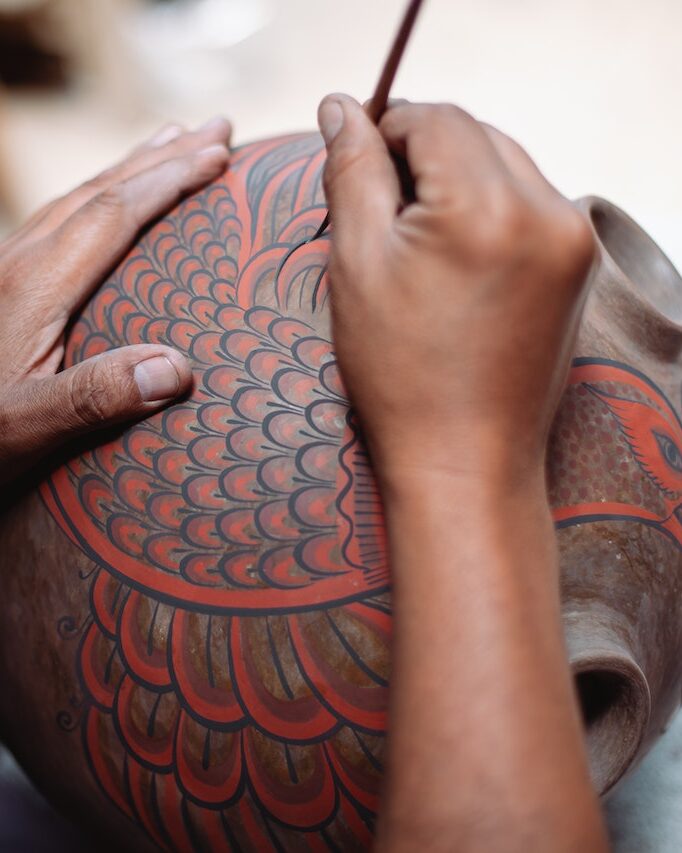Challenges that hinder artisan craft communities from reaching their full potential

All over the world, craft is one of the ways individuals, communities and countries express their unique culture, heritage and traditions. Producing handcrafted products is also a way for craftspeople to earn an income. However, turning craft into a viable living is not always easy. And artisan craft communities, in particular those in developing countries, face several challenges that hinder their efforts to reach their full potential and make a decent living from their crafts.
Some of the key challenges that prevent artisan communities from reaching their full potential include:
Access to market
Without customers, artisans can’t make sales, and market access, be it local or international, is one of the main challenges craft communities face. Navigating the commercial side of the craft business can be tricky. It is not always as simple as turning up at a shop and asking them to sell your products. Contacts with buyers and the ability to negotiate contracts are often out of reach for artisans, especially those in remote, rural areas.
While digital technology has brought the world in closer contact, despite the reach and perceived widespread availability and use of internet-enabled devices, 2.6 billion people worldwide still do not have internet access (World Economic Forum). This equates to roughly one-third of the global population. And, while we may debate the pros and cons of digital technology, we can’t deny the opportunities and freedoms it unlocks for online business, awareness, and market access. Support and guidance are much needed to help artisan communities identify the markets that are suitable for their crafts.
Competitive pricing
Pricing is another challenge that prevents craft communities from reaching their full potential. Many artisans in developing nations rely on local customers and tourists for sales. Locally produced crafts have a reputation for being cheap and readily available, and when crafts are seen as lowly, humble products, customers bargain, driving down prices. This affects the artisan’s profit margin’s leaving them very little to live on and invest back into improving the marketability of their crafts.
Selling wholesale to retailers can help boost a craft community’s income, but without the knowledge or confidence to navigate the process and ensure they get a fair deal, the artisans then face being taken advantage of. If artisans want to widen their reach by selling their creations to international audiences, their pricing needs to match the expectations of a global market.
Product development and innovation
Pricing crafts for retail and international markets requires that the products the artisans produce meet the high-quality standards expected by the contemporary crafts market. While the artisans may have exceptional craft skills, the creations still have to fit in with the modern life of the end consumer, and design development skills may be lacking.
Craft communities don’t always have access to trends and the ever-changing tastes of consumers that dictate what gets bought and what doesn’t at any given period. Products get tailored to suit the tastes of different customers, and taking artisan crafts to wider, diverse audiences requires adaptability. Artisans don’t typically have access to these insights, and their creations, while beautifully made, then become stuck in an aesthetic time-warp, making them unsuitable for markets beyond their immediate communities.
Collaborative design interventions are one way of introducing new ideas into a craft community, but this must be done sensitively and with the creative and technical input of the artisans rather than forced upon them.
Getting product to market
Once crafts have been made, they need to get to market. Depending on the destination, this is by air, sea, or land. Shipping goods can be costly, and also time-consuming if the artisans have to deliver them themselves. If sending crafts internationally, the need for export licences and insurance are all factors that may be out of the reach of artisans, barriers that stand in the way of them reaching their full potential.
Funding
Investing in the development and sustainable success of a craft community requires some form of funding. This could be from the artisans’ own funds or, in the case of communities, more likely to come from external sources such as retailers, donors, grants and micro-loans. This can put pressure on the artisans to deliver, and in the case of loans, at the mercy of unscrupulous lenders. On the other hand, loans and grants from reputable sources may be denied where there is no credit history.
In times of economic uncertainty, funding becomes scarce, and for an artisan community that has relied on funding to achieve its potential, the sudden unavailability can jeopardise its growth. This calls for training to help craft communities learn the necessary skills to manage and invest their income wisely to free them from a reliance on long-term funding support.
Training
Craft skills development and business skills are essential to help artisan communities reach their full potential. Selling, marketing and communicating the purpose and stories behind their crafts are much-needed skills for connecting with customers and buyers. Having access to training is to improve on existing knowledge and to empower those who get held back due to things like illiteracy, which causes others to look down on or take advantage of them. Even for those who are literate, areas such as financial education, bookkeeping, product pricing, packaging and promotion go a long way towards enhancing their prospects and well-being and that of their community.
When artisan craft communities flourish, they not only contribute to the wider craft industry, they also empower those within the community, who in turn contribute to the prosperity of their nations. And, the right support ensures this can happen. If you are interested in collaborating with artisan communities to create products for your artisan retail business and want to know more about the challenges, have a look at my consultancy services.
– Tapiwa Matsinde
[Image credits: The image shown is sourced from Los Muertos Crew from Pexels. If downloaded and used elsewhere, please credit accordingly.]






